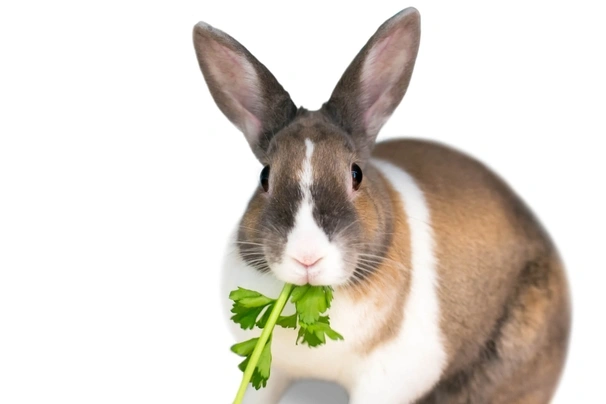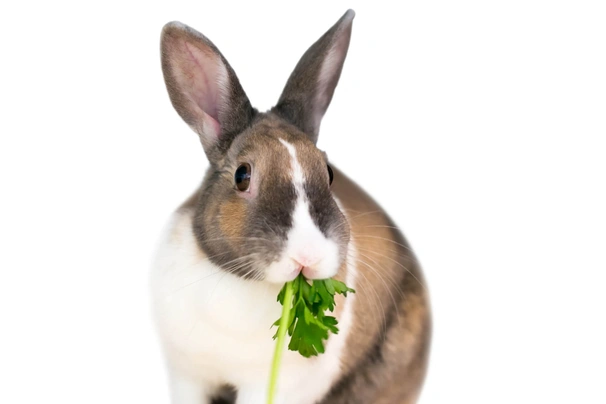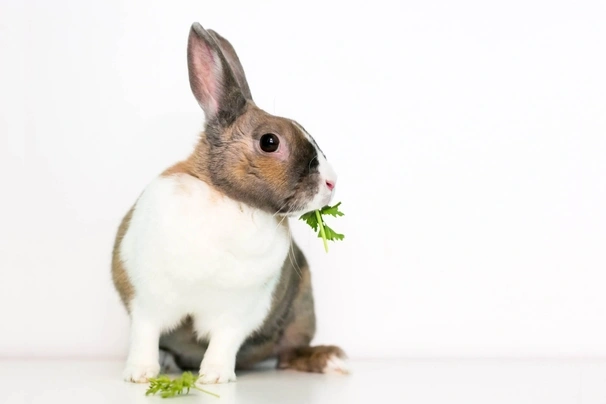Tri Coloured Dutch
Introduction of the Tri Coloured Dutch
The Tri Colour Dutch Rabbit is also known as the Japanese or Harlequin Dutch and was founded in the Netherlands by crossing the Harlequin with the tortoiseshell Dutch. It’s currently recognised in the UK by the British Rabbit Council, but not by the American Rabbit Breeders Association.
The Tri Colour Dutch should have white areas in the same places as the traditional Dutch breeds, but the coloured areas must be a mix of orange with blue, black or chocolate.
History of the Tri Coloured Dutch
The history of the Tri Colour is very much entwined with the history of the other Dutch breeds. In the early years of the 19th century many rabbits were imported into the UK from Belgium for food and among these animals was a breed known as the Petit Brabançon. This diminutive breed is portrayed in Flemish art dating back to the Fifteenth Century.
This little rabbit displayed the distinctive Dutch markings we know today. Many rabbit enthusiasts in the UK were enchanted by this unusual animal and decided to the ‘fix’ its markings, and in doing so created the founders of the Dutch breeds we see today.
The Tri Colour animals are a result of putting the tortoiseshell Dutch with the Harlequin, to produce the distinctive markings of the Tri Colour Dutch.
Appearance of the Tri Coloured Dutch
- Main colourways: white markings with orange and either black, blue or chocolate
- Average weight: 1.7 – 2.5kg
The Tri Colour is a small rabbit that displays the distinctive Dutch markings, with white areas coupled with coloured patches that are orange with black, blue or chocolate. The fur is short, soft and glossy. The coat is also very thick, with a dense undercoat and lots of guard hairs.
The body is rounded and ‘cobby’ with a short neck and a head held centrally between well-muscled shoulders. The ears are around 10cm long and robust, while the chest is deep and strong. The legs are fine and the hind legs are held parallel to the body. The cheeks are full and round and according to the breed standards, must not touch the whisker bed.
The standard is very exacting regarding the pattern of the coat. One cheek must be orange and the other should be blue, black or chocolate, depending on the type of tri-colour you have. The ears must each be the opposite colour to the corresponding cheek. The face must display a white blaze. The other markings match those of the Dutch, with the saddle making a true ring around the body and the coloured area displaying alternative orange and black (or blue or chocolate) banding.
Temperament of the Tri Coloured Dutch
The Dutch breeds tend to be quite demanding of their owners as they are intelligent, active and quick-witted, and will therefore require a good deal of stimulation. They are even tempered and docile, so they can be handled by children and first-time owners, but any owner should be prepared to spend a lot of time entertaining their pet and providing plenty of mental and physical stimulation such as space to explore outdoors, a range of toys, training games and boxes and logs he can climb, chew and hide in.
Providing an owner does their research and buys from lines known to have good temperaments then they will be rewarded with a biddable, clever animal that will make a fantastic companion.
Young children should always be supervised when around animals. Most rabbits are afraid of being picked up, so anyone who needs to carry one needs to know how to do it properly. A frightened rabbit can struggle if handled incorrectly and a struggling rabbit is very strong and could easily injure itself or its handler.
Health of the Tri Coloured Dutch
All rabbits’ teeth must be regularly monitored. Their teeth grow constantly and therefore a diet very high in roughage is in order to keep his teeth worn down. Hay and fibrous green vegetables will help with this and gnaw toys can also be introduced to encourage him to chew and wear his teeth. It’s important owners also check the teeth and the mouth of their pet themselves at regular internals as symptoms of dental issues can look very similar to the symptoms of other conditions. If you think your pet has a dental problem veterinary advice should be sought.
A rabbit’s diet should be managed in order to prevent him becoming obese. An overweight rabbit can suffer from a number of health conditions – not least flystrike. If a rabbit is allowed to become overweight he will be unable to groom himself and if he develops areas of dirty fur, flies can be attracted to these soiled places, where they will lay eggs. Maggots can then break through the rabbit’s skin and cause wounds that are extremely painful and will need treating by a vet.
Any rabbit should be treated regularly for worms, ticks and fleas and must also be vaccinated against myxomatosis and Viral Haemorrhagic Disease, conditions which are highly infectious and which can be fatal.
Caring for the Tri Coloured Dutch
The Tri Colour Dutch will live very happily outdoors providing his hutch is sufficiently weather and waterproof and safe from predators. The floor should be completely solid to prevent sore hocks and it should be lined with hardwood shavings and straw. The rabbit must have a covered nesting area and the whole space should be big enough for him to hop about and stand on his hind legs.
If you are thinking about getting a rabbit as a pet, do remember that they are social animal and may not thrive if forced to live alone. Two rabbits are always better than one, and two neutered males or a neutered male and a female with get along very well.
If your Tri Colour is going to live indoors it must be offered a cage or crate where he can go for some quiet time away from people and other pets. Household items like as wires and cables must be kept out of his way and he should be trained to use a litter tray.
Rabbit pellets and good hay should form the basis of his diet and he should also be given green vegetables such as cabbage, spring greens and kale. He must have access to clean, fresh water at all times.


